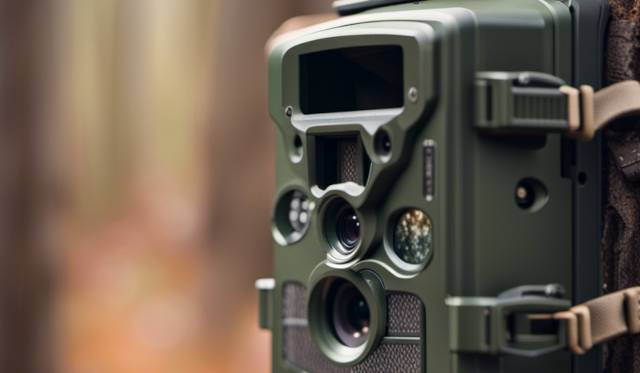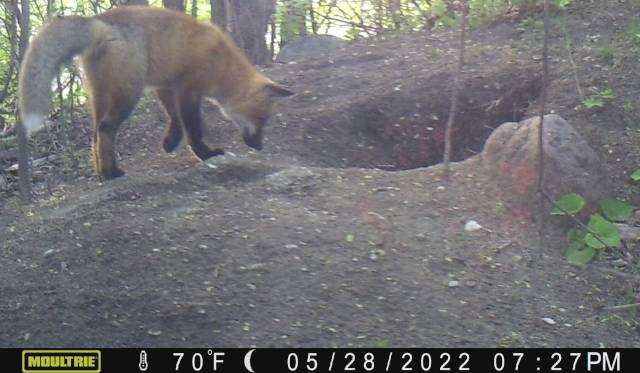Trail cameras have become an incredible tool for hunters, wildlife enthusiasts, and cabin owners alike. So how does a trail camera work? These compact devices are designed to capture high-quality images and videos of people and wildlife.

Contents
- How Does A Trail Camera Work
- Types of Trail Cameras
- Trail Camera Purpose and Usage
- Trail Camera Features
- Storage and Connectivity
- Battery Life and Power Options
- Accessories and Additional Features
- Frequently Asked Questions
- How do trail cameras capture images?
- What triggers a trail camera to take pictures?
- Can trail cameras send pictures to your phone?
- Do trail cameras need internet connection?
- How do trail cameras store footage?
- What types of trail cameras are there for security purposes?
- What’s the difference between a Wi-Fi trail camera and a cellular trail camera?
- Related Articles:
How Does A Trail Camera Work
Basic Components
A trail camera is a specialized device designed for snapping videos and images of wildlife in their natural habitat. Its main components include a lens, infrared flash, and a motion sensor. When you set up a trail camera, it’s crucial to position it in a manner that maximizes the coverage of the area you want to monitor.
Infrared Technology
Infrared technology plays a vital role in game cameras. Depending on the type, your camera may utilize a red glow or no glow infrared flash. Red glow cameras emit a faint red light when taking pictures, which may be slightly visible to humans and animals.
No glow cameras produce an entirely invisible flash, allowing for more stealthy monitoring. The infrared flash helps your camera capture clear images, even in low light conditions or during the night.
Motion Sensors and Triggers
One of the key features of a game camera is its motion sensor. The sensor detects movement and heat, activating the camera when motion is detected within its range. The motion sensor sensitivity can be adjusted depending on your specific needs.
Once triggered, the camera rapidly takes a series of photos or records a video clip, providing you with valuable insights into the wildlife activity in the area.
Types of Trail Cameras
Cellular Trail Cameras
A cellular trail camera offers a convenient way to receive real-time notifications and photos directly to your phone using an app. These cameras typically work on the AT&T or Verizon networks, so it’s essential to choose the one with the best service in your area, regardless of your personal mobile provider. Cellular trail cameras work as an independent device from your personal cell phone.
Cellular trail cameras use a sim card and a data plan to send captured images and information to your device, allowing you to monitor your property from anywhere you have a cellular signal.
WiFi Trail Cameras
WiFi trail cameras, unlike their cellular trail camera counterparts, use a local Wi-Fi connection to send images and notifications. These cameras are ideal for locations with a nearby Wi-Fi network, such as home security or wildlife monitoring within range of your house or cabin.
Keep in mind that a Wi-Fi trail camera requires a steady and stable connection to function properly. A significant advantage of using a Wi-Fi trail camera is that there are no additional monthly fees or data charges, as it relies on your existing Wi-Fi network.
Flash Trail Cameras
Flash trail cameras use a visible flash to capture images at night, illuminating the area for a clear and detailed photo. These cameras can provide more precise and higher quality images compared to infrared trail cameras.
However, the visible flash may startle animals or intruders, alerting them to the camera’s presence. Flash trail cams are ideal for situations where clear, high-quality images are the priority, and the flash’s visibility is not a concern.
Trail Camera Purpose and Usage
A good trail camera, also known as game camera, serves multiple purposes for different individuals and scenarios such as for hunting and scouting, by wildlife enthusiasts, and for home security purposes.
Hunting and Scouting
For hunters, a trail camera is an essential tool for scouting and monitoring game activity. By placing game cameras in strategic locations, you can gather valuable information about wildlife movements, patterns, and behavior.
This helps you to better plan your hunting strategy and pinpoint the best locations and times to set up your hunting blind. The recorded images and videos of game animals also give you the insights to identify specific animals, their gender, and their approximate age, which is crucial for a successful hunt.

Wildlife Enthusiasts
If you’re passionate about nature and wildlife, installing a trail camera can help you observe animals in their natural habitat without disturbing them. This non-invasive method allows you to capture images and videos of various species and behaviors that might otherwise go unnoticed or be difficult to observe.
By setting up game cameras for wildlife in different locations and habitats, you can study and appreciate the diversity of wildlife in your area. The data collected can contribute to research and conservation efforts, helping to protect and preserve these wild animals.
Home Security
Game cameras are not limited to just nature and wildlife enthusiasts; they are also effective tools for home security. Due to their motion-activated detection and night-vision capabilities, these cameras can be strategically placed around your property’s perimeter, capturing any suspicious activity or trespassers.
The recorded images and videos can serve as valuable evidence in case of theft or vandalism. Cellular trail cameras enable you to receive real-time notifications and images directly to your phone, making it easier for you to monitor your home and take appropriate measures when needed.
Trail Camera Features
Image Quality
When it comes to capturing wildlife, the image quality of your trail camera is crucial. You want high-quality images that provide clear details and color accuracy. Most trail cams offer adjustable resolutions, with higher megapixels resulting in better image quality.
However, keep in mind that higher resolution images also consume more storage space on your SD card. Consider your needs and balance image quality with storage capacity accordingly.
Trigger Speed and Recovery Time
Trigger speed refers to the time it takes for your trail camera to detect motion and capture a photo or video. Faster trigger speeds are essential for capturing fast-moving animals, ensuring you don’t miss any important moments.
In general, a trigger speed below one second is considered fast, while anything above two seconds may result in missed opportunities.
Recovery time is the period between consecutive captures. A shorter recovery time allows your camera to quickly be ready for the next shot, increasing your chances of capturing more images and action. Aim for a trail camera with a recovery time of around one to three seconds for optimal performance.
Detection Zone
Your trail camera’s detection zone is the area where it can sense movement and trigger image capture. When positioning your camera, make sure it faces an area with high animal activity to increase the chances of capturing interesting moments. Detection ranges vary between models, but typically fall between 50-100 feet.
Be mindful of factors that could impact detection, such as foliage, terrain, or camera height. It’s crucial that your trail camera has both wide-angle detection and an extended detection range to ensure it covers a large area, increasing your chances of capturing quality wildlife photos.
Storage and Connectivity
Memory Cards
A trail camera stores captured images and videos on a memory card, usually an SD card. You should make sure that your trail camera supports the desired capacity of the SD card for storing your data.
Higher capacity SD cards allow you to capture more images and videos without the need to replace the memory card frequently. You can easily access the stored data by pulling the SD card from the camera and plugging it into a compatible device, such as a computer or smartphone. You may need a SD card reader compatible with your device.

Cellular Network and SIM Cards
Cellular trail cameras, make use of cellular networks to transmit images and videos to a cloud-based system or your smart devices. This feature is particularly beneficial for those who want to view the captured footage remotely, without having to visit the camera location frequently.
To enable this feature, ensure that your cellular trail camera can connect consistently to a cellular network. You’ll need to insert a compatible SIM card into the camera to establish a connection with the cellular service provider.
Wireless Service
Wireless trail cameras, also known as Wi-Fi trail cameras, operate by connecting to a wireless network. Once connected, the camera sends the captured images and videos to a device that is also linked to the same wireless network.
This means that you’ll need a reliable Wi-Fi network where your trail camera is installed for optimal performance. Keep in mind that the range of the Wi-Fi connection may impact the performance of the wireless trail camera, so make sure it is within a reasonable distance from the Wi-Fi source.
Battery Life and Power Options
When it comes to game cams, battery life and power options play a crucial role in keeping your camera operational and capturing images of wildlife.
Battery Types and Life Expectancy
There are various battery types to consider for your trail cams, but their performance and life expectancy can differ. Here’s a quick overview:
- Alkaline batteries are the most common and affordable option, but they may not last as long in extreme temperatures and might have a shorter lifespan compared to other options.
- Lithium batteries are an excellent choice as they tend to have a longer life and are capable of handling colder temperatures. They may be more expensive, but the extended battery life often justifies the cost.
Most trail cameras battery life varies depending on factors such as your camera settings, the type of batteries you use, and how frequently the camera is triggered.
Adjusting settings like reducing photo resolution or selecting photo mode over video mode can help extend battery life significantly.
Keep in mind that life expectancy is not just about the battery’s capacity but also the camera’s power consumption during resting and active states.
Solar Panel Powered Trail Cameras
If you want a more sustainable and eco-friendly solution for powering your trail camera, solar panel options are an excellent way to go. Solar-powered trail cameras typically come with a built-in solar panel or have a compatible solar panel attachment.
These game cameras use sunlight to charge an internal battery, which in turn powers the camera. This option can save you both time and money, as you won’t need to keep replacing batteries or disturb the wildlife to change them.
It’s essential to consider the location of your trail camera when choosing a solar-powered option. Ensure that the solar panel has enough exposure to sunlight throughout the day for optimal charging.
While this option may not be as efficient in heavily shaded or cloudy areas, solar panels can still provide a nice add-on to your trail camera set-up.
Accessories and Additional Features
Tripods and Mounts
Maximize your trail camera effectiveness by investing in tripods and mounts. Using a tripod allows for easy height adjustment and positioning while ensuring stability.
Mounts offer versatility by allowing you to secure the camera to a tree or other structures. This way, you can capture optimal angles and cover a wider area.
Timelapse and HD Video
Another feature to explore with a game camera is the timelapse function. With timelapse settings, your camera can automatically take photos or videos at specific intervals.
This enables you to monitor animal activity patterns or even watch the growth of vegetation over time. It’s essential to choose a trail camera with a high-definition (HD) video recording feature if you prefer high-quality, detailed images and videos.
Cams offering infrared or LED technology provide clear and sharp images even in low light conditions, ensuring that you don’t miss a moment.

Frequently Asked Questions
How do trail cameras capture images?
Trail cameras capture images using motion detection and infrared sensors. When an animal or person passes by the camera, the sensors detect the heat and movement, triggering the camera to take a photo or record a video. The images and videos are then saved to an SD card within the camera for later viewing.
What triggers a trail camera to take pictures?
A trail camera is triggered to take pictures when it senses a combination of heat and motion. This means that an animal or person must pass close enough to the camera to be detected by the camera’s infrared sensors, which then activate the camera to capture an image or video.
Can trail cameras send pictures to your phone?
Yes, trail cameras, specifically cellular trail cameras, will capture and send pictures directly to your phone. Cellular trail cameras use a built-in cellular connection to transmit the images and videos captured by the camera to your phone or other devices via text message or email.
Do trail cameras need internet connection?
A standard trail camera doesn’t require an internet connection to function. If you’re using a Wi-Fi or cellular trail camera, internet connectivity is necessary for features like remote image viewing and real-time notifications.
How do trail cameras store footage?
Trail cameras typically store footage on a removable SD card inside the camera. The storage space of the SD card determines how much footage can be stored before it becomes full. The camera will either overwrite older files or stop capturing new images and videos, depending on its settings as it becomes full.
What types of trail cameras are there for security purposes?
For security purposes, there are various types of trail cameras, such as Wi-Fi-enabled and cellular trail cameras. These trail cameras work with features like real-time notifications, remote image viewing, and the ability to transmit images and videos to your phone or other devices.
What’s the difference between a Wi-Fi trail camera and a cellular trail camera?
A Wi-Fi trail camera connects to a Wi-Fi network and uses it to transmit images and videos to your devices, while a cellular trail camera uses a built-in cellular connection for transmission. Wi-Fi trail cameras require a local Wi-Fi network to function. Cellular trail cameras can operate anywhere there’s cellular coverage.